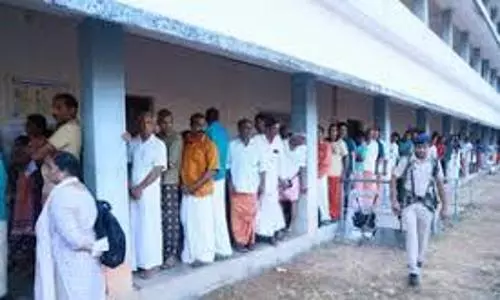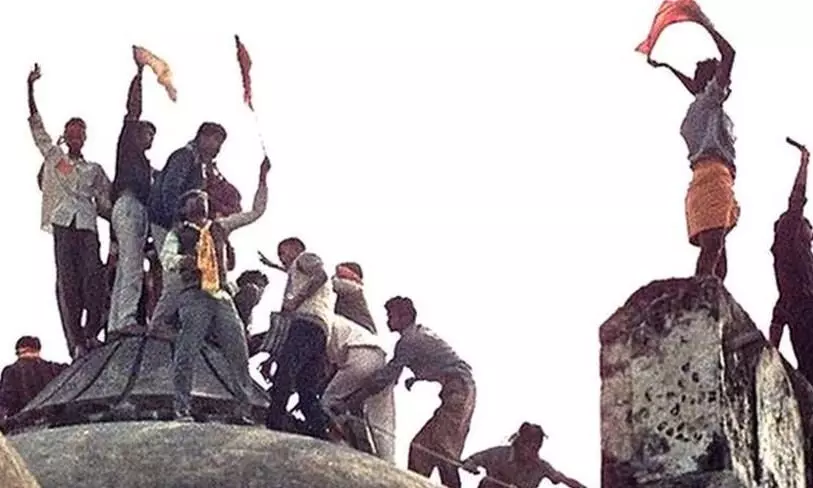
30 years after Babari Masjid's fall: Hindutva erected on Masjid's rubble
text_fieldsLUCKNOW, December 6: Precisely 30 years back this was a black day in the history of independent India when Hindutva forces pulled down the 16th century Babri Masjid in the ancient Hindu temple town of Ayodhya, barely 130 km from the state capital of the country's most populous northern state of Uttar Pradesh.
It was clearly an act of aggression, that India's secularists had never imagined in their wildest dreams. The demand for possession of that mosque had been in the pipeline for years from the right-wing Hindutva forces under the open patronage of the country's then-most prominent opposition party – BJP. And even as the party was ruling in Uttar Pradesh, the then chief minister Kalyan Singh had sworn an affidavit before the Supreme Court assuring that his government would abide by its constitutional duty to not allow any harm to be caused to the mosque.
Yet, on December 6, 1992, tens of thousands of people were allowed to assemble in every nook and corner of Ayodhya from where select mobs charged at the mosque and carried out their obviously planned mission of razing the entire sturdy structure built in the name of Mughal emperor Babur in 1527.
While the demolition was naturally taken with shock and dismay by the bulk of India's population which always upheld secular principles and ideals, there was this then minority of Hindu fundamentalists who made no bones about proudly revelling over what they termed as their "victory".
The act naturally incited violent communal frenzy in different parts of the country and many lost their lives on both sides. With the passage of time, Muslims did manage to heal their wounds. Even as the matter was investigated by CBI and taken up by a special court in UP, the case (like any other case in a lethargic judicial system) was allowed to linger on for years. Having been an eyewitness to the entire demolition, I also deposed before the court, where my cross-examination by more than half-a-dozen lawyers went on for two weeks. And that itself was after 22 years of the demolition. Mind you, there were hundreds of witnesses like me.
Even as the criminal act of demolition was still being heard by the special courts, the High Court in Lucknow finally concluded its hearings in 2009 on the title of ownership of the land on which the mosque was built in the 16th century. The verdict was split between the three judges constituting the bench. So the matter had to reach the Supreme Court, which finally ruled in favour of the temple in October 2019. For whatever reason, the act of demolition was condoned and today a grand temple is under construction in Ayodhya.
Though with a heavy heart, Muslims of the country probably had no choice but to quietly accept the verdict. But there was still hope among the larger section of the minority community that this would bring an end to the increasing bitterness between Hindus and Muslims. A law enacted by the Congress government in 1991 to protect the status of all other places of worship (Ayodhya was exempted since the dispute was already pending before the court) somehow gave reassurance to not only Muslims but also to the secular-minded Hindu majority that the Hindu hardliners would allow the country to live in peace.
But evidently, that was not how destiny was written. Hindutva forces, who always openly looked down upon the very fundamentals of secularism made it a point to sharpen the divide between Hindus and Muslims. And BJP's position of increasing political power gave them the strength and arrogance to go ahead with their mission.
Actually, the seeds of the communal divide were sown with the demolition of the Babri Masjid, though many contests that the nation's secular ethos was eroded because of Rajiv Gandhi's bid to reverse a court verdict through special legislation in the infamous Shahbano case in 1985.
However, fact remains that December 6, 1992, became a turning point in India's political history. The demolition of the Babri Masjid became a tool to polarise Hindus in order to acquire political power. And nothing succeeds like success.
Even though their initial stride was impeded because of the rise of the backward castes, who got a huge political boost with the advent of the Mandal commission in 1989. Still, with the active support of RSS and other Hindutva organisations like Vishwa Hindu Parishad (VHP), Bajrang Dal, etc, BJP did manage to ride on to power a couple of times, not only in Lucknow but also in Delhi.
Soon the Hindutva forces began working on the downtrodden castes. The first move came when they succeeded in forging a divide between Samajwadi Party founder Mulayam Singh Yadav (representing a conglomeration of backwards) and Bahujan Samaj Party (BSP) founder Kanshi Ram in 1995. The two parties had shaken hands to set up a truly formidable combine to beat the traditional political hold by both Congress and BJP, widely regarded as upper caste parties.
Sure enough BJP and its ideologue RSS knew that if the SP-BSP combine was allowed to thrive, it would shatter their dream of "Hindu Rashtra". So they found a smart way to 'divide and rule'. BJP clearly baited BSP by offering chief ministership to then BSP vice-chief Mayawati if BSP agreed to part ways with Mulayam. A deal was struck and BSP chief Kanshi Ram went to then-UP Governor Moti Lal Vora announcing the withdrawal of support to the then SP-BSP government headed by Mulayam.
What made it even more smooth for BJP to have its way was the violent reaction by Samajwadi Party. SP leaders and supporters attacked Mayawati while she was holding a meeting of her party MLAs in Lucknow's State Guest House on June 2, 1995. While BJP had played its card, Congress found it convenient to settle scores with Mulayam, who had upstaged the Congress in 1989. Vora instantly installed Mayawati as UP CM. BJP repeated this support for Mayawati two more times. And even if the marriage of convenience never lasted long, BJP succeeded in sending a message to Dalits that it was ready to take them into their Hindu fold.
Even the traditional Muslim support for the Congress had got severely eroded because Mulayam went out of the way to support the cause of the Babri Masjid in 1990 when he ordered firing on violent Hindu karsewaks who tried to storm the mosque. In its bid to beat the BJP in their game, Congress had chosen to play a Hindu card by organizing a 'shilaniyas' (foundation stone laying) of the much-debated Ram temple in Ayodhya in 1986.
If BJP's 'divide and rule' worked to initially forge a split between Dalits represented by BSP and backwards represented by SP, the same formula came in handy to divide Hindus and Muslims in the years that have followed.
Playing the politics of hate became their key tool to achieve this vicious goal. And each time, they achieved success, even sharper daggers were drawn next time. It may not be wrong to assume that BJP cleverly adopted the 'divide and rule' line from the British, who had managed to rule here for 200 years.
2014 became the watershed of this politics of 'divide and rule'. While it was initially laced with the promise of "development", which was systematically projected under the illusion of the "Gujarat model", the subsequent national election in 2019 and state elections in states including UP over the years between 2014 and 2017, Hindutva forces sharpened their knives.
The demolition of Babri Masjid was highlighted as an insignia of their achievement and the construction of the Ram temple was shown as prime minister Narendra Modi's gift to the Hindus. Saffron-clad chief minister Yogi Adityanath's loud and echoing references to Babri Masjid and Ayodhya have only helped the BJP to further gain ground and to brand any other political party talking about fundamental rights of Muslims as "anti-Hindu".
And now that Babri Masjid has paid such huge political dividends to the BJP, the Hindutva forces are evidently out to replay the same strategy in Varanasi and Mathura. And the game is no more subtle. The effort is on to now dilute, amend or even nullify the Places of worship Act 1991 which was seen as a safeguard and guarantee for all religious shrines after the fall of Babri Masjid. Sadly, in today's politics, this is what pays.
























